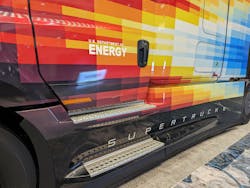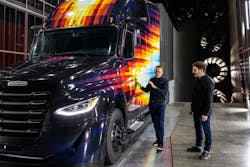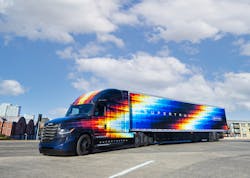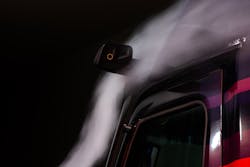Freightliner’s SuperTruck II previews diesel’s more efficient future
LAS VEGAS—Diesel might not be powering long-haul tractor-trailers decades from now. But the fuel will continue to be the primary energy source for over-the-road freight transportation for the rest of this decade. North America's largest truck maker showed off ways that it plans to squeeze every ounce of efficiency out of a gallon of diesel over the coming years.
With advanced aerodynamics, low-rolling resistance tires, powertrain improvements, and energy management with advanced technologies, Daimler Truck North America has built its most efficient diesel-powered truck in history. It can even roll down the highway without the engine running, thanks to its EcoSail system.
Sign up: FleetOwner's new Emissions & Efficiency weekly newsletter
Wrapped in colored blocks of reds, oranges, yellows, and blues that resemble a hot flame—and "U.S. Department of Energy" emblazoned the cab doors—DTNA unveiled its Freightliner SuperTruck II during Manifest 2023, a supply and logistics conference, at the Caesars Forum. The second iteration of the Freightliner SuperTruck was designed to show off innovative features to offer the next level of long-haul, on-road freight efficiency.
As part of the SuperTruck program—co-funded by the Department of Energy to reduce emissions from on-road freight transportation—DTNA engineers and designers worked over the past five years to create next-generation technologies for this Class 8 Freightliner Cascadia that could potentially integrate into future series productions. Freightliner's original SuperTruck featured new technology and designs that are now part of newer Cascadias on the road.
Other major U.S. truck OEMs have created their own SuperTrucks since the first versions debuted in 2015. Paccar's Peterbilt unveiled its SuperTruck II last fall. The third SuperTruck initiative, which sets its sights on electric fuel-cell trucks, is already underway. But the industry is still focused on making diesel more efficient until a cleaner energy source replaces it.
"Diesel will remain the predominant propulsion choice for the foreseeable future—because it suits 100% of all applications," John O'Leary, DTNA president and CEO, told trucking industry media before a sneak preview of the high-tech Freightliner tractor. "It remains the most cost-effective and efficient way to move goods and people. And we're far from done with it."
DTNA remains committed to a zero-emission future, O'Leary stressed. For now, the OEM is focused on improving diesel efficiency and zero-emission technology for over-the-road freight. "At least until 2039, when we've announced that we will be out of the diesel business," he said.
O'Leary said the Energy Department's SuperTruck program pushes OEMs to take "high-risk chances on ideas. As with SuperTruck I, some of those ideas proved to be infeasible for the field. But others found their way into production, including innovations like engine thermal efficiency and powertrain integration technologies such as downspeeding and predictive powertrain controls. SuperTruck II allows us to go even further. We focus on technologies and ideas that can be realistically implemented. We do not do science projects at DTNA, we stay prudent with our own money, with our investors' money, and we did it here, too."
'Core truck' improvements fuel SuperTruck II
While DTNA engineers continue to develop zero-emission heavy-duty and medium-duty vehicles for the future, they are also focused on the current fleet landscape across the U.S., noted Derek Rotz, DTNA's director of advanced engineering.
"Diesel will still be part of our portfolio, and we aspire not only to achieve transformation with these new technologies, we also want to make sure that the vehicles we develop today are also set up to be the most efficient and best-selling products out there," Rotz told industry media the night before SuperTruck II was unveiled to trucking, shipping, and logistics executives gathered for the Manifest conference and exhibition. "Projects like SuperTruck II here enable us to help move the needle on those technologies."
See also: DTNA expands service network, discusses equipment backlogs
Enhanced tractor aerodynamics, low-rolling resistance tires, powertrain improvements, and energy management with advanced technologies are among the SuperTruck II innovations that could become part of future Freightliners.
DTNA focused on "core truck components" improvements for this version of the SuperTruck, according to Rainer Mueller-Finkeldei, SVP of engineering and technology at DTNA. "Taken all together, the combined innovations developed for the Freightliner SuperTruck II have provided us the opportunity to explore the technologies needed to meet stringent and forthcoming Greenhouse Gas reduction requirements in the coming years."
SuperTruck I overachieved Energy Department requirements in 2015. DTNA said its SuperTruck II surpassed expectations in aerodynamics, tires, powertrain, and energy management—while doubling the freight efficiency of the base vehicle from the start of the SuperTruck program. Rotz said the SuperTruck II was getting more than 12 miles per gallon of diesel during testing.
Instead of radically changing the truck's structure, the design goal for SuperTruck II was to redefine the existing shape of the Freightliner Cascadia to maximize aerodynamic efficiency and simultaneously employ advanced design language to convey that efficiency. Daimler's design and engineering departments' aerodynamic improvements reduced the aerodynamic drag of SuperTruck II by more than 12% over SuperTruck I.
"We wanted to create a shape that makes efficiency exciting," said Jeff Cotner, chief designer at DTNA. "The designers imagined the surfaces of the truck being carved away by the wind. Nature has a way of creating the perfect sculptural shape when the material is light and airy, like snow or sand. This was our inspiration in creating the new expressive form language for the Freightliner brand."
The redesigned hood, bumper, and chassis fairing all work with the existing cab structure to allow air to flow undisturbed around the truck. Cotner explained that the grille, air intakes, and doors were redesigned to be as seamless and clean as possible; no sharp edges compromise the aerodynamics or beauty of the truck.
The design studio and engineering team refined other critical areas in an iterative approach: Active side extenders and a roof spoiler system closes the trailer gap by up to 4 inches at highway speeds and an enhanced Aerodynamic Height Control lowers the truck inches off the ground for additional aerodynamic improvements.
Designers also improved aerodynamics by removing the mirrors from the tractor and replacing them with a mirrorless camera system, which requires federal exemption by the National Highway Traffic Safety Administration.
Freightliner integrates its most efficient powertrain
SuperTruck II features the most efficient powertrain Freightliner has integrated into a truck. The highly efficient powertrain enables a 5.7% fuel consumption reduction over SuperTruck I. With a noncertified prototype Detroit 13-liter engine featuring two-stage turbo and interstage cooling and a 13-speed overdrive transmission, the powertrain can achieve lower downspeeding and more significant fuel savings through reduced drag overdrive.
See also: Diesel average up again—but only slightly
SuperTruck II's powertrain features split cooling. The system consists of high-temperature and low-temperature cooling circuits, working with two-stage turbocharging and Exhaust Gas Recirculation (EGR) cooling on the engine. Together, these technologies create more efficiency gains, enabling more aggressive downspeeding.
A smart engine lubrication circuit minimizes internal pumping losses, thus reducing engine parasitics by actively proportioning flow to the most sensitive components.
With adaptive tandem axles, another innovation helps increase fuel efficiency. It allows increased torque from the fuel-efficient powertrains and automatically shifts from 6x4 to 6x2 at highway speeds which benefits the driver when maneuvering at low speeds.
DTNA and Michelin create dynamic load shift tires
By lowering the friction on the road, less fuel is needed to maintain the truck's speed. The engineers significantly reduced the tractor rolling resistance by 12% over SuperTruck I.
DTNA collaborated again with SuperTruck I partner Michelin to create new tires designed for adaptive tandem axles to reduce vehicle energy consumption and maintenance downtime due to minimized wear and tear on the tires.
See also: Tire outlook for 2023
In development with DTNA, Michelin designed tires specifically for SuperTruck II's steer, drive, and tag axles. The dynamic load shift increases efficiency. With this technology, some of the load is shifted automatically from the drive axle to the tag axle to take advantage of the tag tire's low rolling resistance.
The design of the new tires included the development of new treads and compounds that translated into more than 20% improvements in drive tire wear and tear and overall significantly improved rolling resistance.
Energy management benefits the SuperTruck driver, too
SuperTruck II features an innovative 48-volt electrical system with lithium-ion batteries, enabling a new electric steering system to adjust demand as needed, whether the operator is maneuvering at low speed, driving at highway speeds, or operating during EcoSail while the engine is off.
The intelligent EcoSail feature can turn the engine off when drive power is not needed without requiring any intervention from the driver. At the same time, if the truck is coasting down a hill while the engine is off, features like air conditioning remain in operation. As soon as power is needed, the engine will restart automatically for a seamless experience for the driver.
More 48-volt features resulted in decreased fuel consumption and increased driver comfort, such as a new electric air conditioning system that consumes 50% less energy than SuperTruck I and continues seamless operations while the engine is turned off.
A 48-volt starter turns on the engine with more power and speed. The new electrical system also operates the hoteling features without the engine running while delivering 12-volt power for the standard cab items like lighting or the instrument cluster.
Cascadia already has some 'SuperTruck' in it
"We certainly support zero-emission technology and see it as the long-term path forward," O'Leary said. "But there are many challenges to get there, which is why we're focusing on proceeding at the 'speed of the right.' Projects like SuperTruck help us to reduce the emission profile of our fleets now."
Some innovative features from DTNA's first SuperTruck are available today in the Freightliner Cascadia, including enhanced aerodynamics, improved engine thermal efficiency, and powertrain integration technologies such as downspeeding, and predictive powertrain controls.
Rotz said SuperTruck II technologies, such as the mirrorless camera system, which still needs regulatory approval, could be part of future Cascadias. He noted that designs for the SuperTruck II aren't necessarily production-series ready, but DTNA's engineers are proving that what's on its new SuperTruck is "within striking distance."
DTNA has also been awarded a grant for SuperTruck III to develop a hydrogen fuel-cell electric tractor that exceeds heavy-duty long-haul sleeper performance, efficiency, and range requirements without compromising payload.
SuperTruck III designs should be revealed by 2027. DTNA's continued involvement in the SuperTruck program aligns with its relentless pursuit of improved customer and driver experiences and increased freight efficiency and resource conservation.
About the Author
Josh Fisher
Editor-in-Chief
Editor-in-Chief Josh Fisher has been with FleetOwner since 2017. He covers everything from modern fleet management to operational efficiency, artificial intelligence, autonomous trucking, alternative fuels and powertrains, regulations, and emerging transportation technology. Based in Maryland, he writes the Lane Shift Ahead column about the changing North American transportation landscape.




